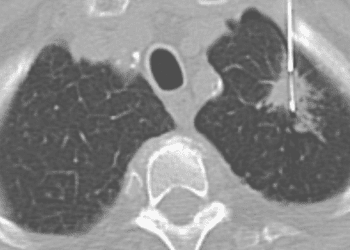Researchers improve lung cancer risk model by incorporating more risk factors
Feb 21st – Published today in NEJM, the PLCOM2012 model is more sensitive than current criteria for predicting lung cancer.
[tabs tab1=”2MM Rundown” tab2= “2MM Full Report”]
[tab]
Image: PD
1. The PLCOM2012 model is more sensitive than current criteria for predicting lung cancer.
The National Lung Screening Trial (NLST) has shown that screening high-risk individuals for lung cancer using low-dose CT can reduce lung cancer mortality. Thus, it is important to accurately identify high-risk individuals for such screening.
Published today, authors of a new NEJM study argue that the NLST criteria of age and smoking history omit other useful information that could identify more high-risk individuals. In this paper, they have shown that the PLCOM2012, which incorporates more risk factors than the NLST criteria, is more sensitive, but no less specific than the NLST criteria. Thus, it could help improve lung cancer screening efforts by more accurately identifying individuals who would benefit from screening.
The wide application of the PLCOM2012 model may be limited, however, by its relative complexity compared to the NLST criteria. It behooves the authors to develop a user-friendly means of applying the model in a clinical setting.
Click to read the study in NEJM
[/tab]
[tab]
Image: PD
1. The PLCOM2012 model is more sensitive than current criteria for predicting lung cancer.
This [statistical] study: The authors developed a new lung cancer risk model called PLCOM2012 based on a model originally developed for the Prostate, Lung, Colorectal and Ovarian cancer screening trial (PLCO). The PLCOM2012 incorporates more risk factors than the current standard criteria of age (55 – 74) and smoking history (≥30 pack-years), which are derived from the National Lung Screening Trial (NLST).
The PLCOM2012 model was tested and validated against data sets from both the PLCO and NLST. In one dataset where the NLST criteria and the PLCOM2012 model were directly compared, the model had a sensitivity of 83.0% compared to 71.1% with the NLST criteria; the model’s specificity (62.9%) was similar to the specificity of the NLST criteria (63.7%).
In sum: The National Lung Screening Trial (NLST) has shown that screening high-risk individuals for lung cancer using low-dose CT can reduce lung cancer mortality. Thus, it is important to accurately identify high-risk individuals for such screening.
The authors argue that the NLST criteria of age and smoking history omit other useful information that could identify more high-risk individuals. In this paper, they have shown that the PLCOM2012, which incorporates more risk factors than the NLST criteria, is more sensitive, but no less specific than the NLST criteria. Thus, it could help improve lung cancer screening efforts by more accurately identifying individuals who would benefit from screening.
The wide application of the PLCOM2012 model may be limited, however, by its relative complexity compared to the NLST criteria. It behooves the authors to develop a user-friendly means of applying the model in a clinical setting.
Click to read the study in NEJM
By Tomi Jun and Mitalee Patil
© 2013 2minutemedicine.com. All rights reserved. No works may be reproduced without written consent from 2minutemedicine.com. Disclaimer: We present factual information directly from peer reviewed medical journals. No post should be construed as medical advice and is not intended as such by the authors or by 2minutemedicine.com. PLEASE SEE A HEALTHCARE PROVIDER IN YOUR AREA IF YOU SEEK MEDICAL ADVICE OF ANY SORT. Content is produced in accordance with fair use copyrights solely and strictly for the purpose of teaching, news and criticism. No benefit, monetary or otherwise, is realized by any participants or the owner of this domain.
[/tab]
[/tabs]


